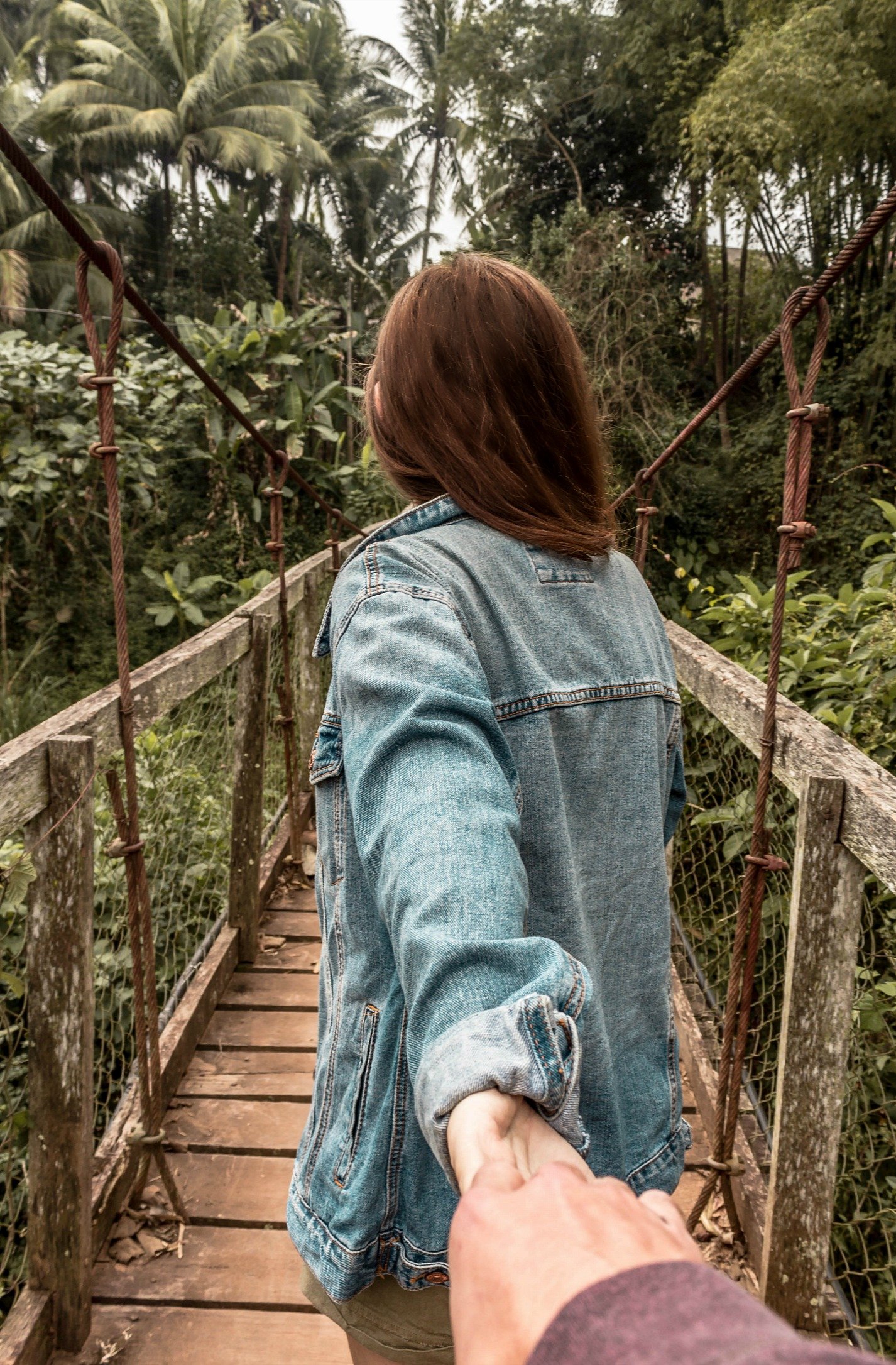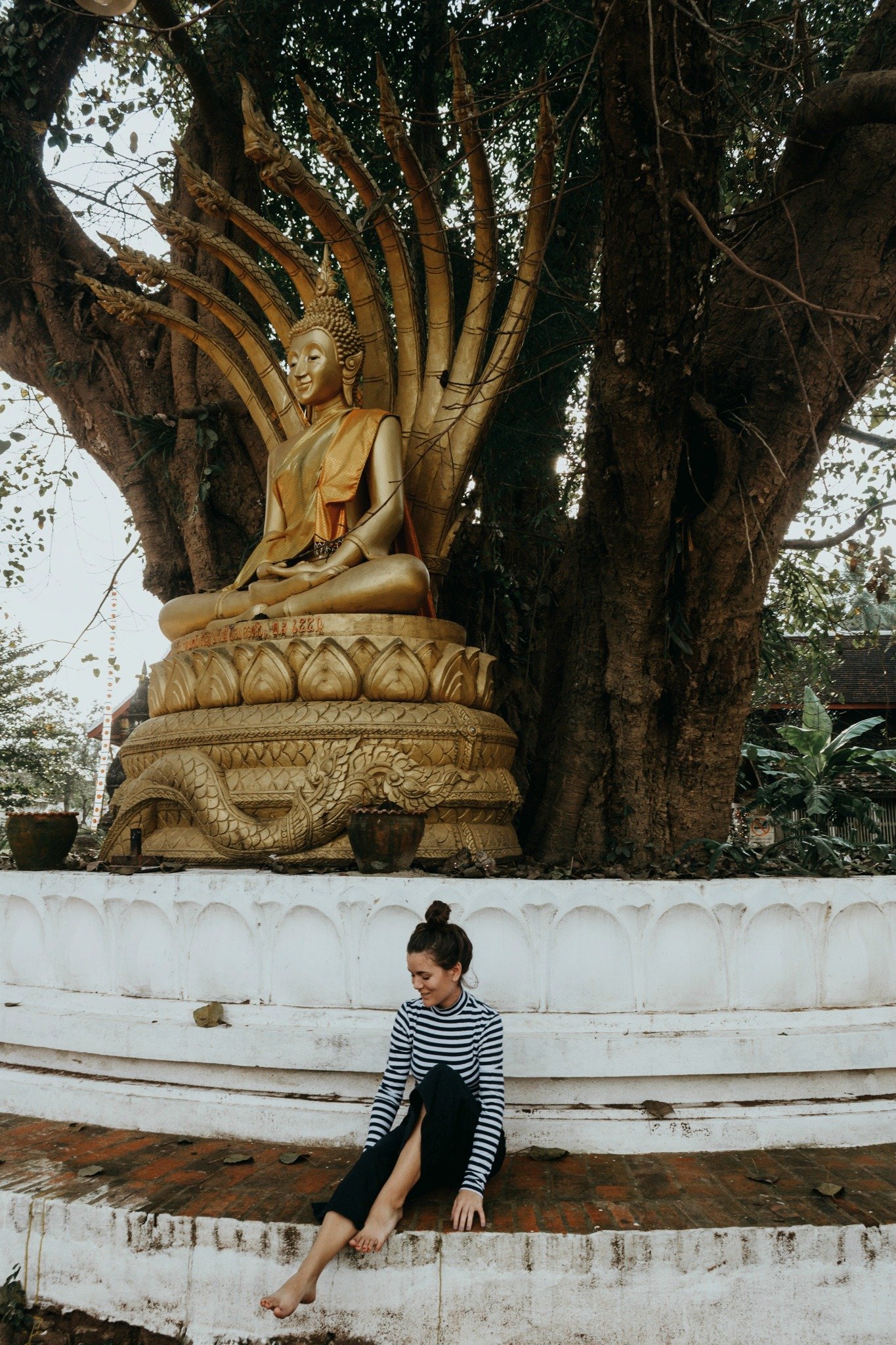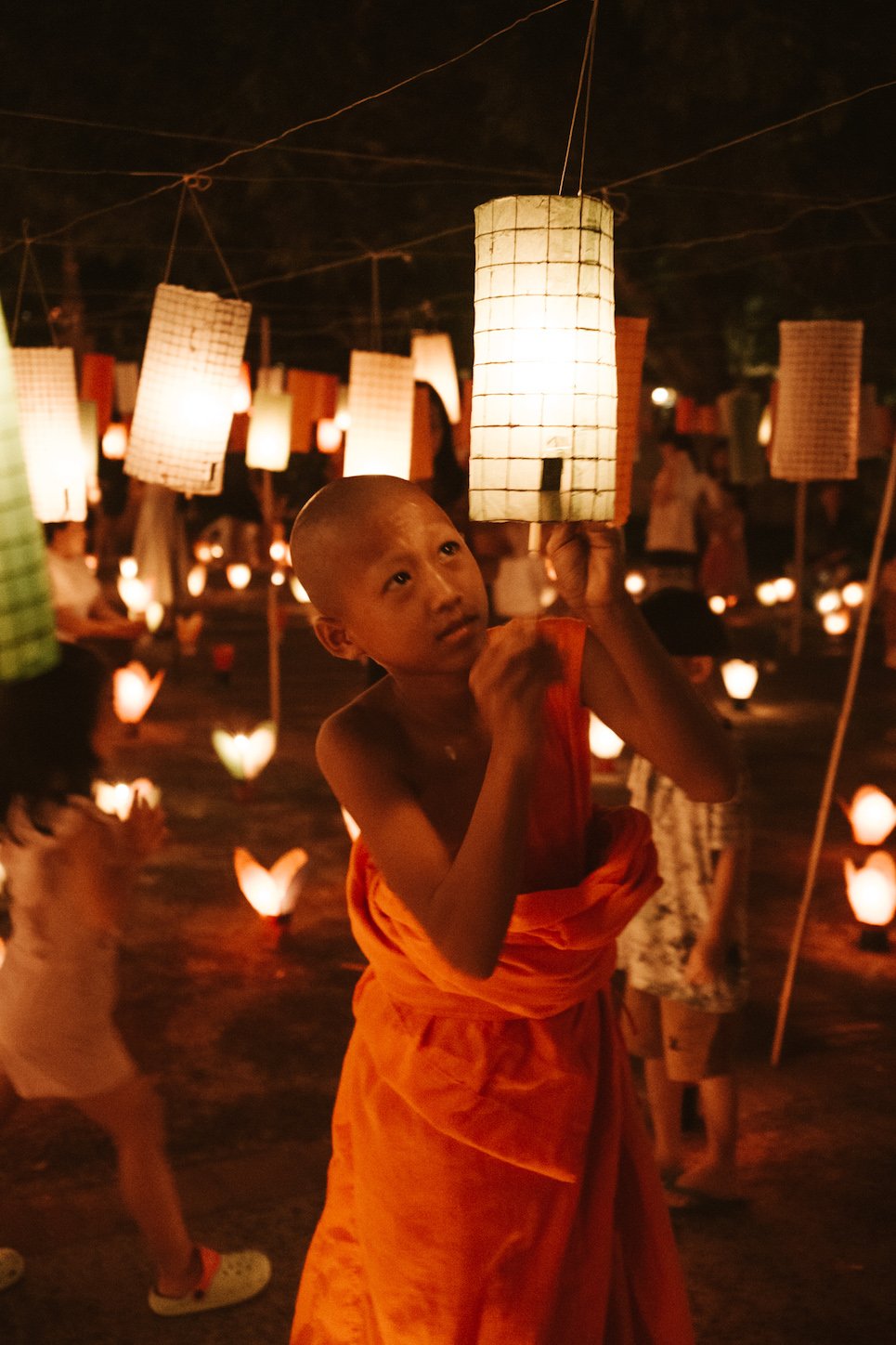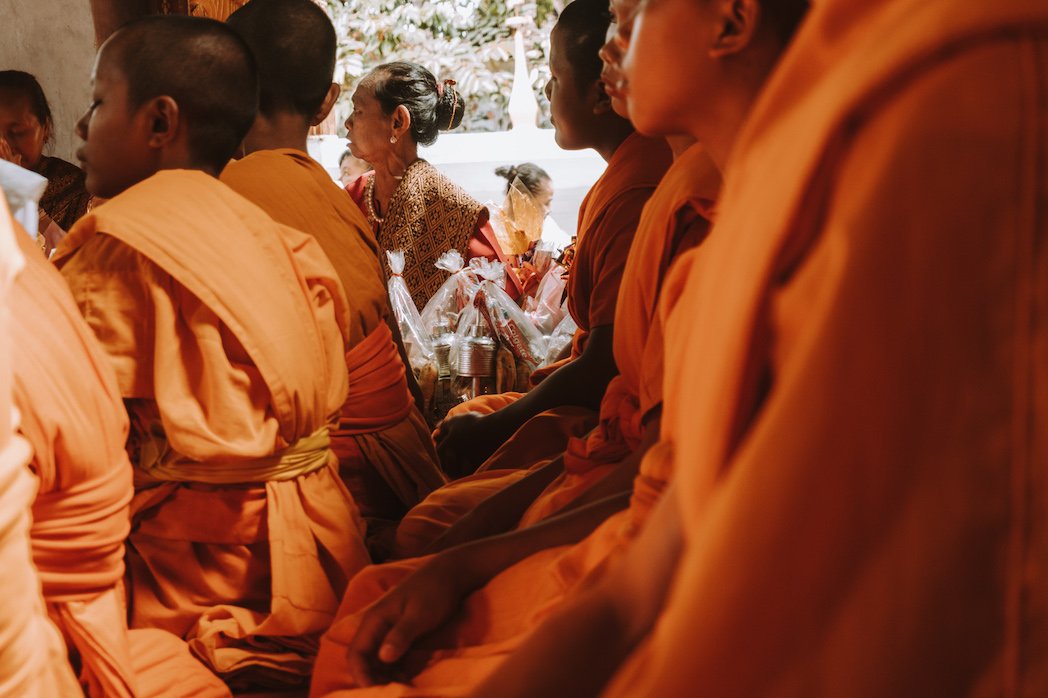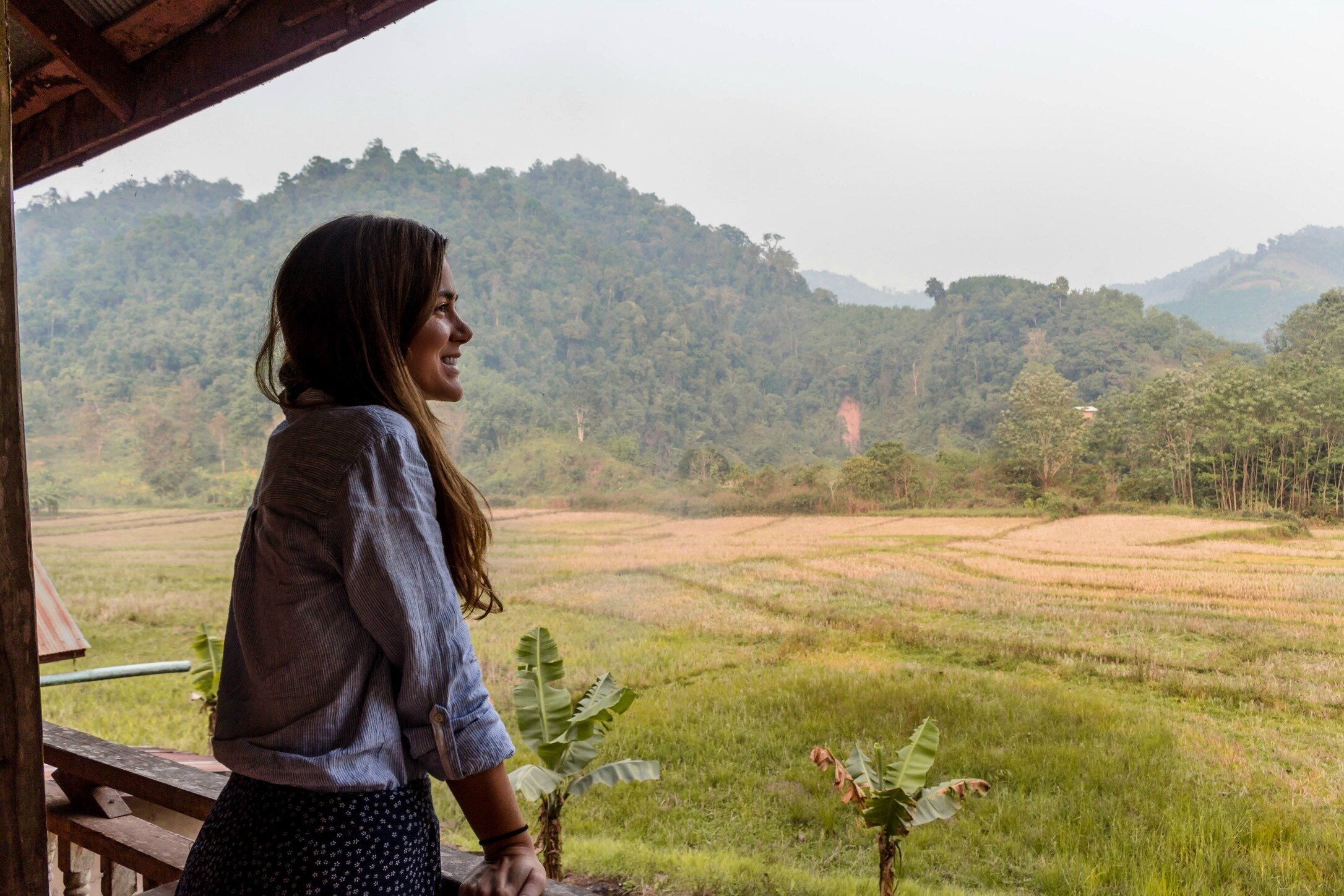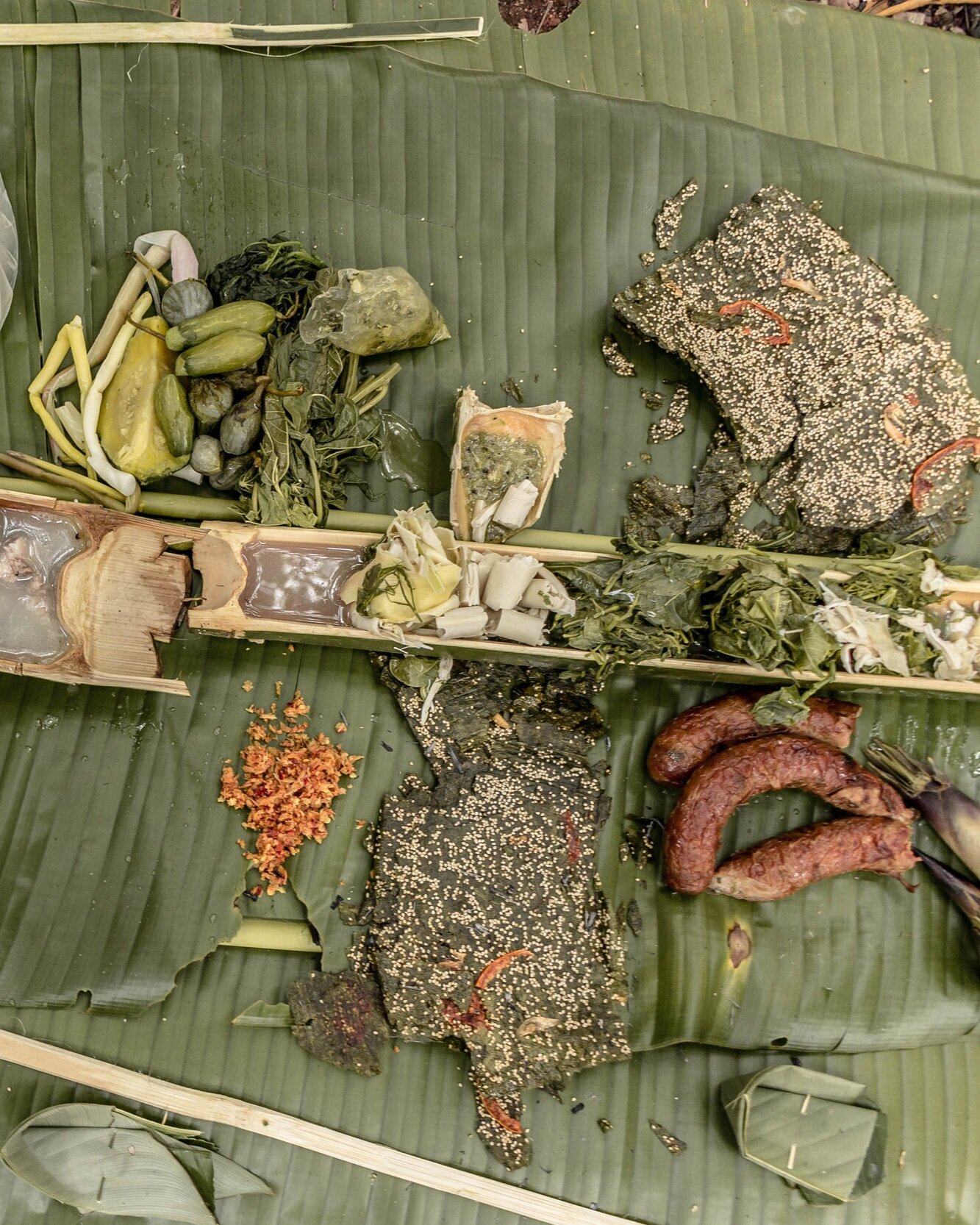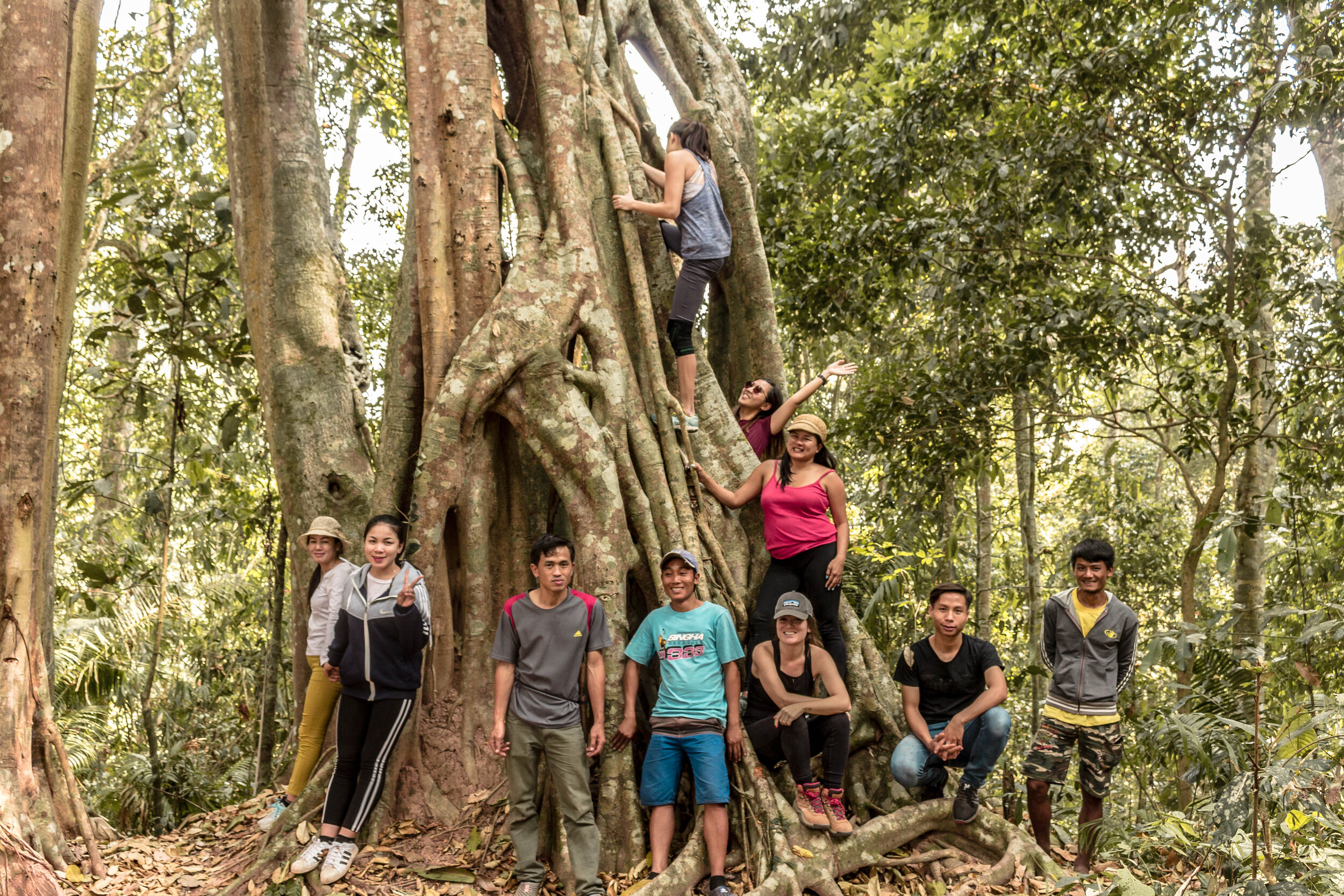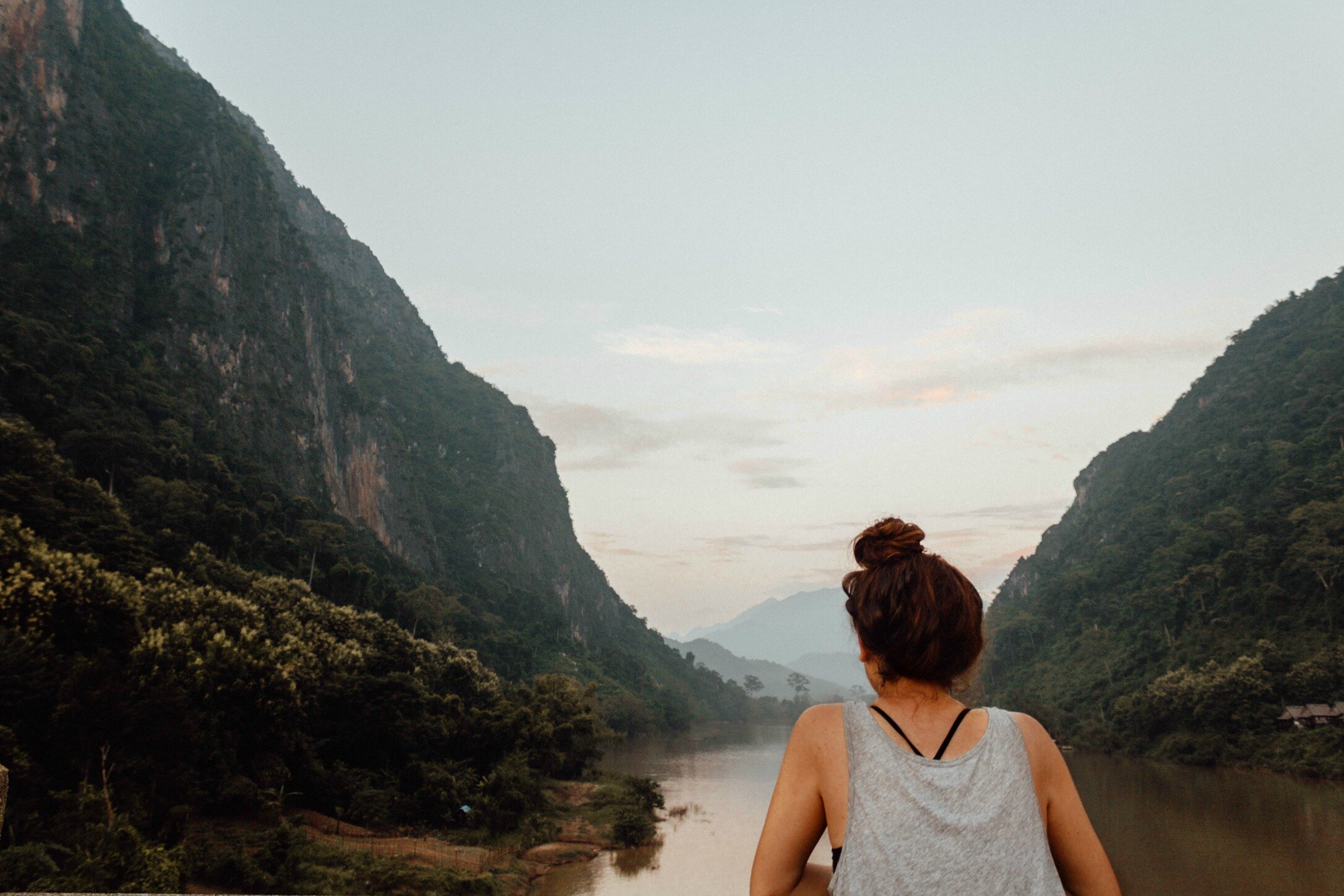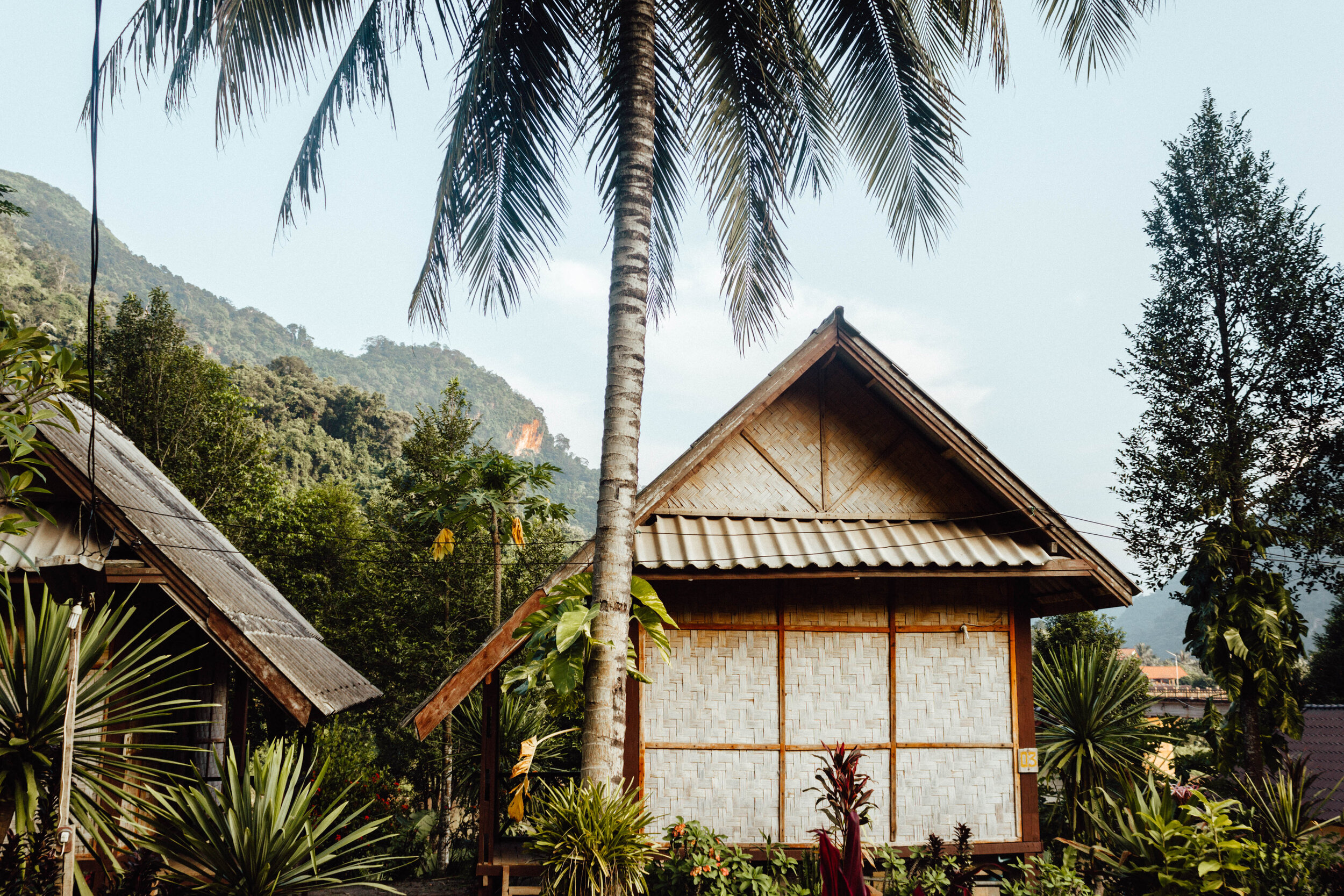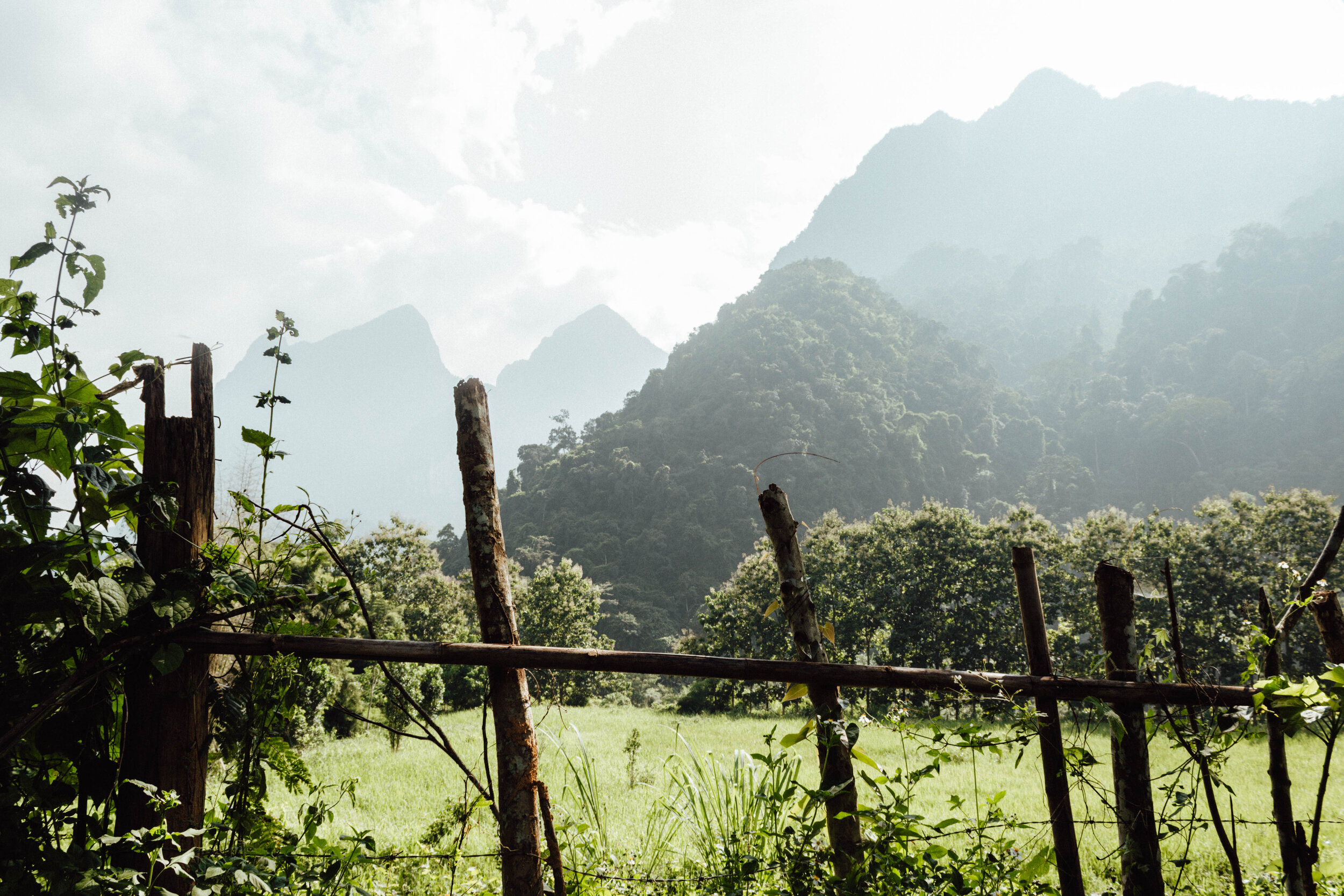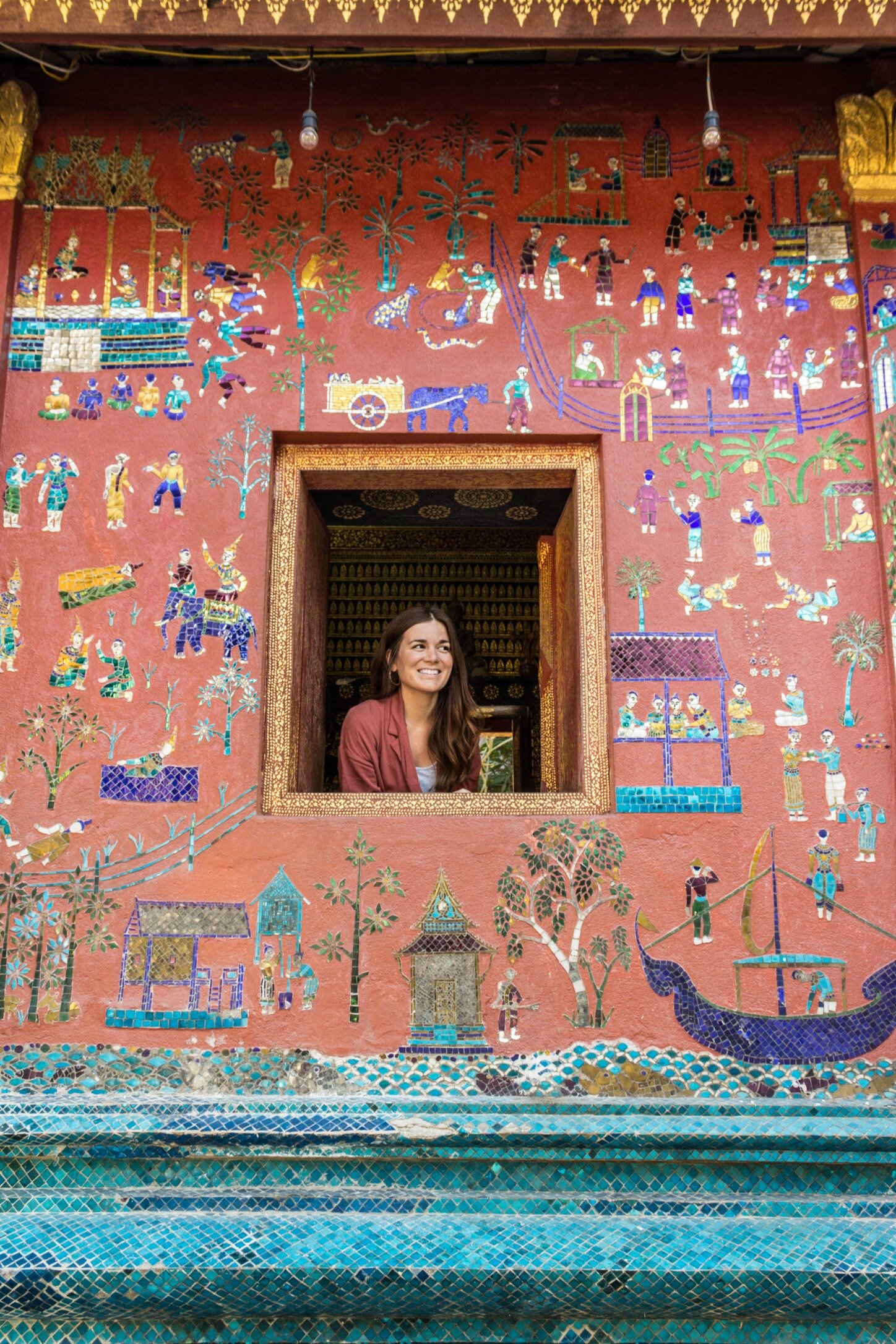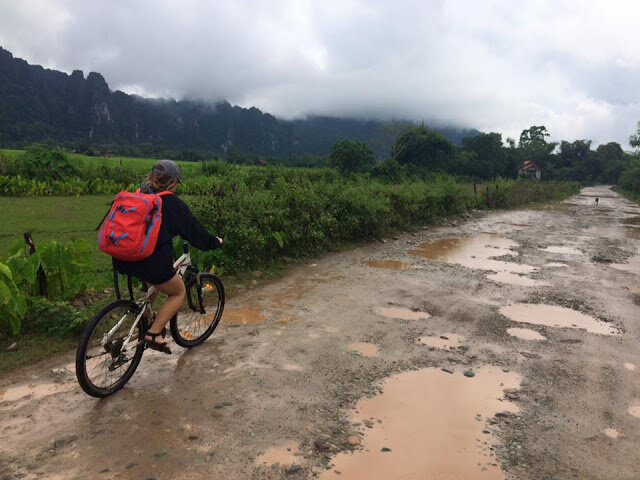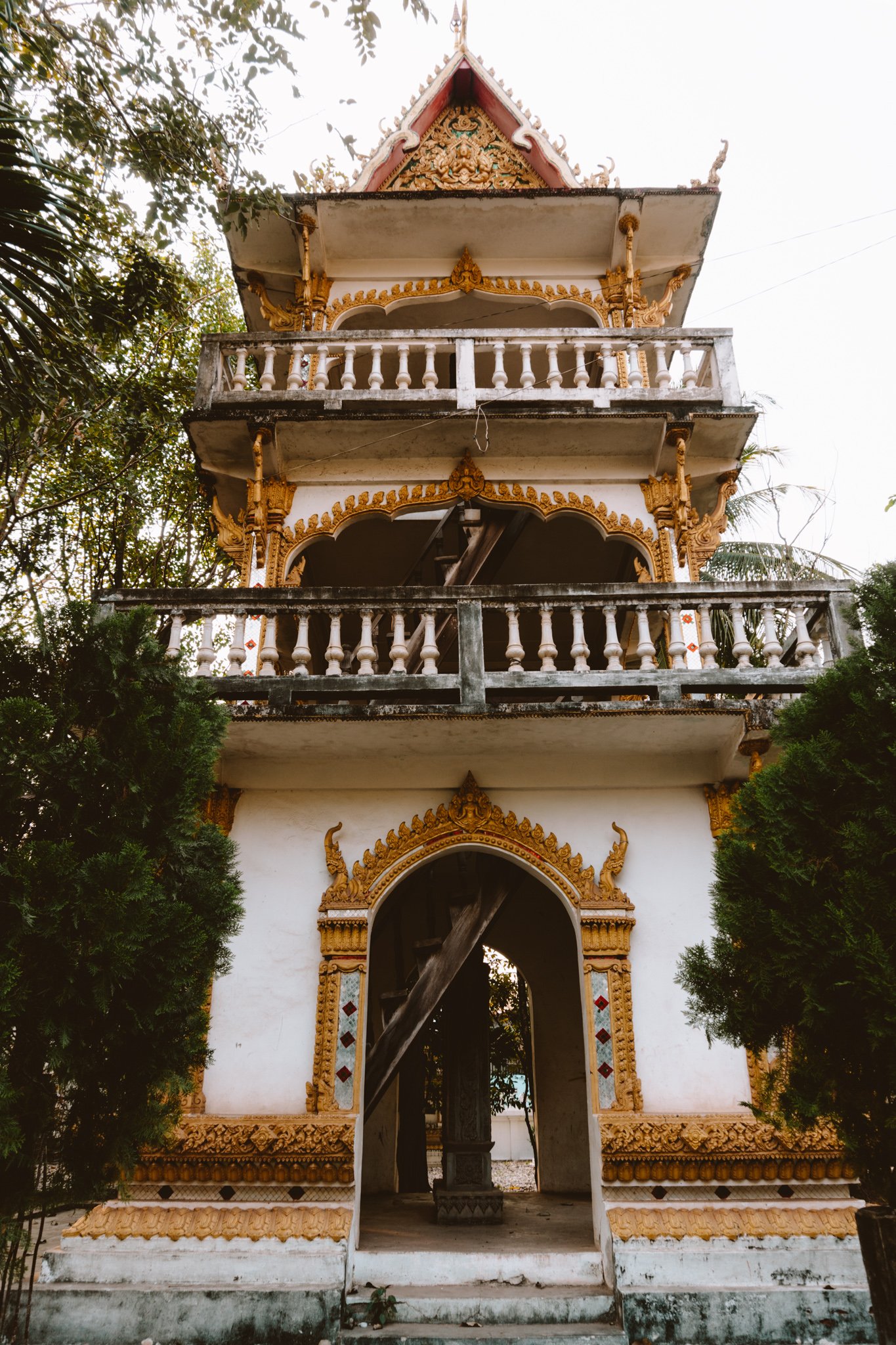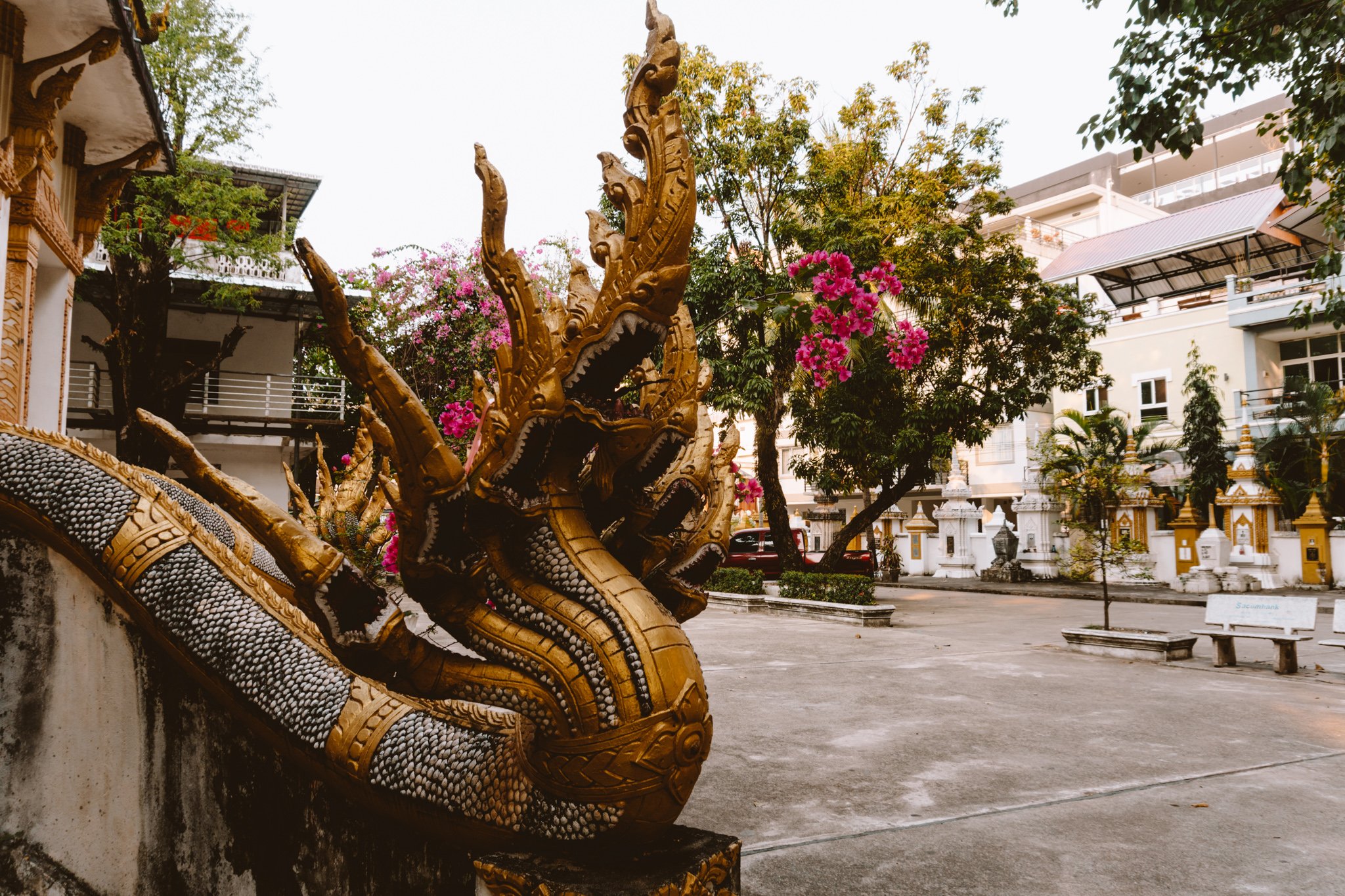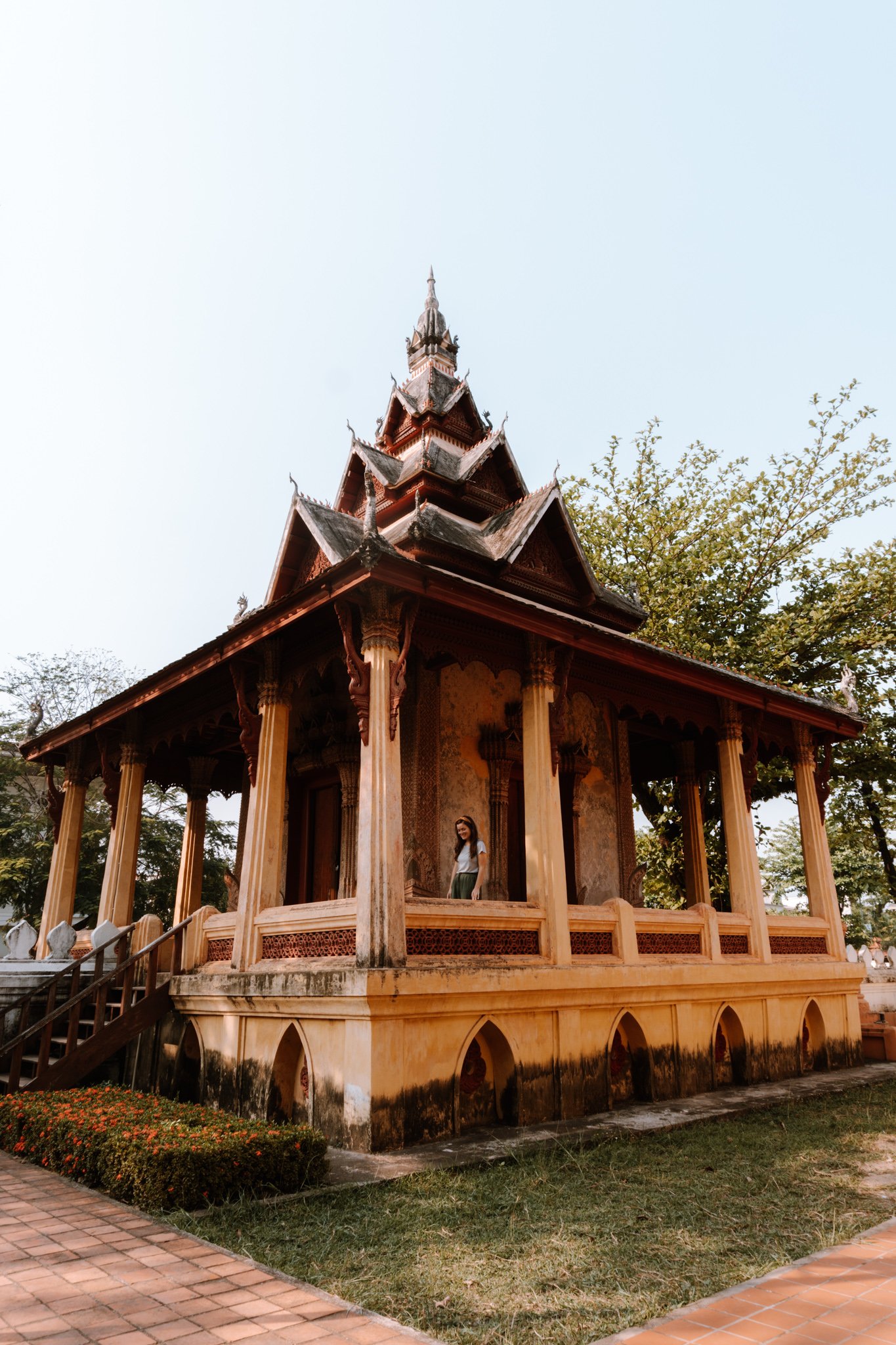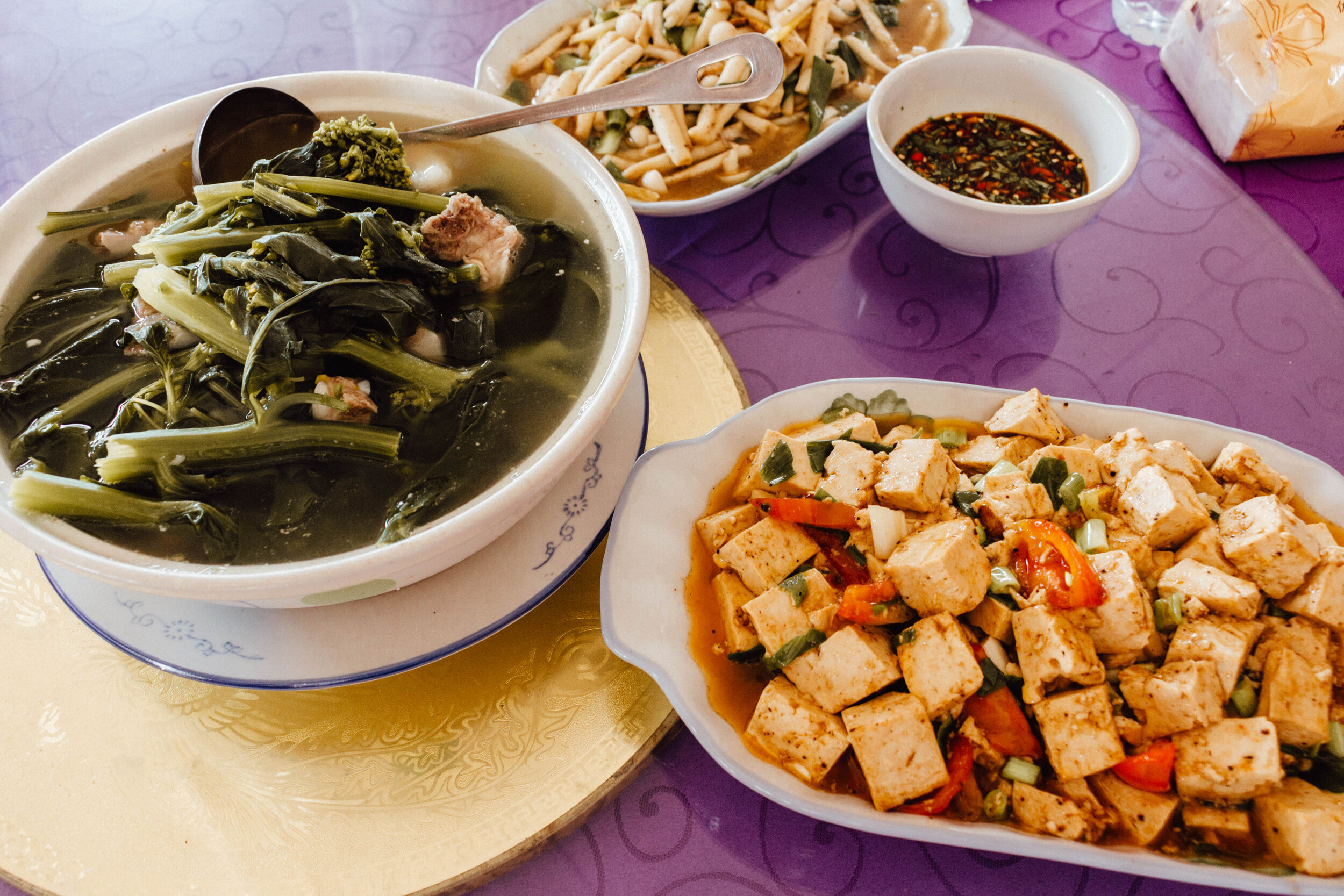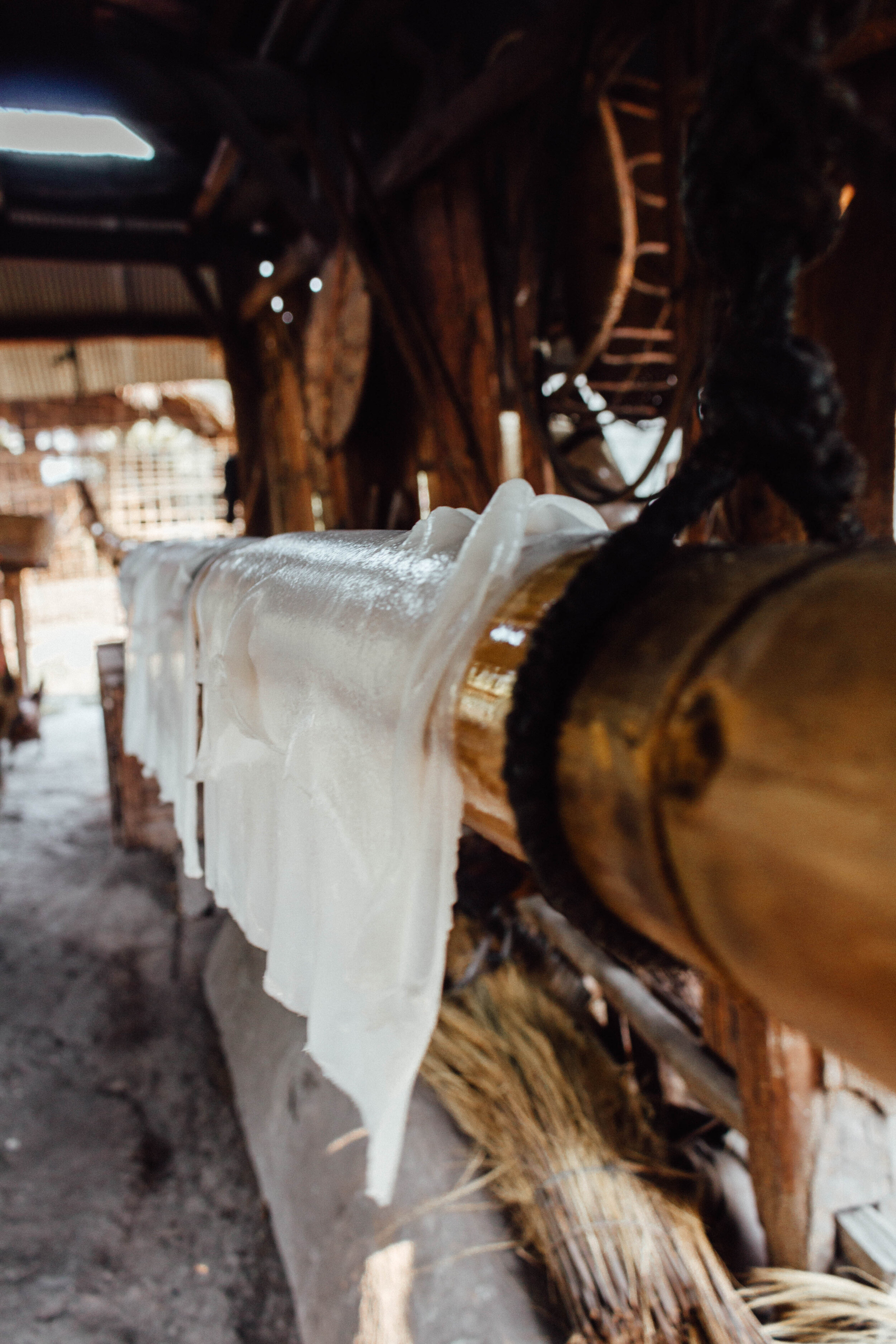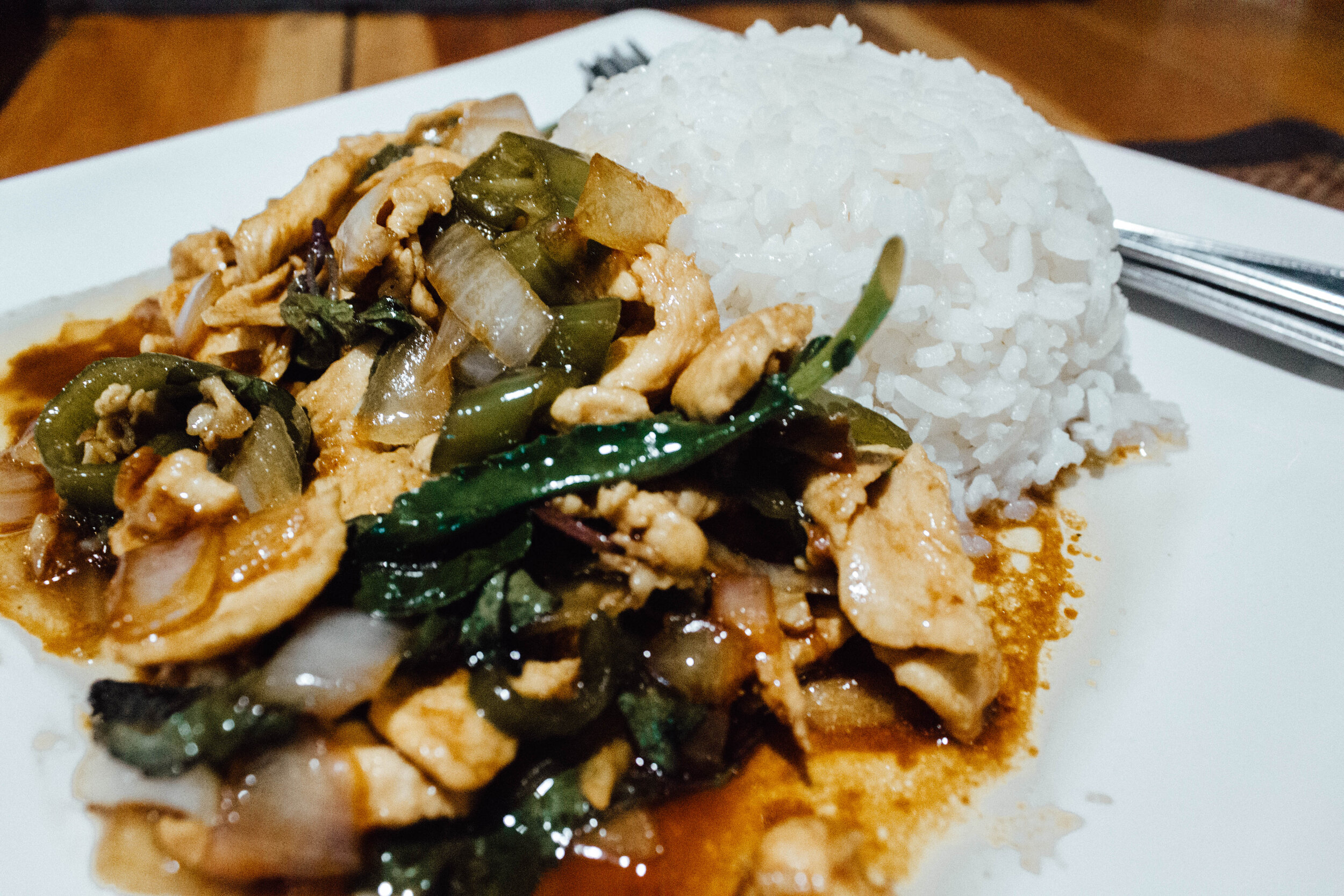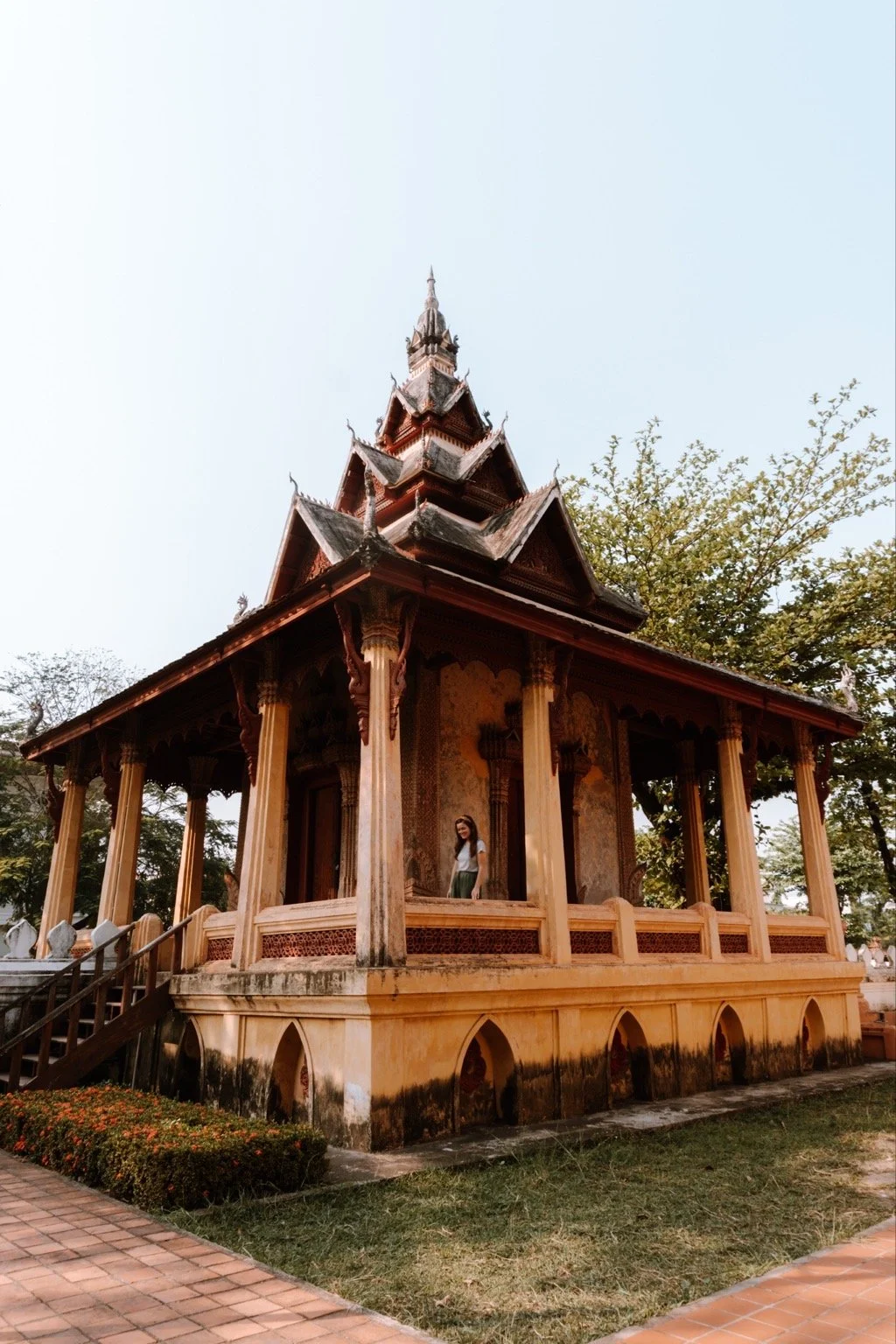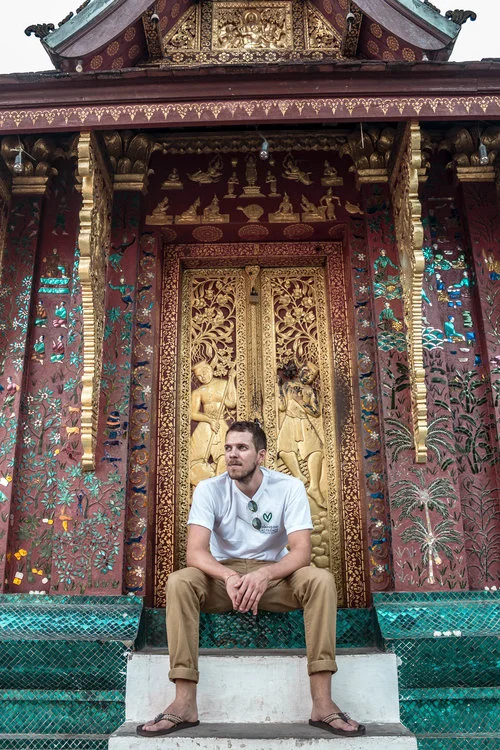The Perfect 2-Week Laos Itinerary for First-Timers (2025)
Planning a trip to Laos and wondering what to do there? Read on for an extensive guide to Laos, complete with 1-week and 2-week itinerary options, as well as practical tips.
Laos may be the most criminally underrated destination in Southeast Asia. After three years spent living, volunteering, and working in Laos, I have perfected one-week and two-week Laos itineraries for tourists who want to explore its lush landscapes, dig into its rich cultural heritage, and discover its many hidden gems. This itinerary details my cumulative knowledge for anyone planning a banger of a trip through Laos.
Laos is the place for adventure travel. Zip-lining, kayaking, tubing, hiking, and cave swims— the landlocked country serves up equal parts adrenaline and sleepy bungalow sunsets. Steeped in Buddhist traditions, delicious coffee, and artisan textiles, there is beauty of all kinds waiting to reveal itself to travelers off-the-beaten-path.
Read on for the most in-depth Laos itinerary and travel guide you could ever need to plan the ultimate trip!
Laos visa requirements ↴
First thing’s first, you need a visa to enter Laos. This is required for traveler’s from most nations, though the price will vary.
visa on arrival
A Laos Tourist Visa is available upon arrival at the airport and is valid for 30 days. From the plane, you’ll wait in the visa line and pay a fee based on your country of origin {or wherever you have a passport from}. This fee ranges from USD $30 – $42. There is also a $2 processing fee. In addition to cash, you’ll need to provide a passport photo. If you haven’t brought a passport photo with you, you’ll have to pay another USD $1 for them to copy your passport’s photo page.
The visa lines in Luang Prabang and Vientiane airports sometimes look very long but, in my experience, they typically move quickly. To avoid this, consider applying to the new Laos E-Visa {information below}.
Laos Tourist Visa on arrival requirements:
1 passport photo- bringing 2 is even better
USD $50 in cash - you’ll get the best conversion rate and many other currencies aren’t accepted
Pen - you’ll be required to fill out a visa application {this takes approximately 3-minutes} and the pens at the airports almost never work {if they have any available to use in the first place}
Address of your intended guesthouse/hostel - you will have to provide this on your visa-on-arrival application
A passport with 6 months validity and 2 empty pages- your Laos visa will {annoyingly} fill one full page
e-visa
Laos is now trial-ing an E-visa that travellers can pick up prior to arriving in the country. The E-visa is a more expensive option for most nationalities since it costs USD$50. The benefit is that it will eliminate the on-arrival visa queues. It is valid for a 30-day visit.
To obtain a Laos E-visa, fill out the form and application online via the Laos e-visa government website. Next, upload a clear passport photo and a picture of your passport’s bio page. This takes approximately 3 business days to hear the visa determination {if you’ve been granted the E-visa or not}. You’ll then be sent an official approval letter to be printed off and brought with you to the airport. You have to enter Laos within 60 days of receiving your approval letter, so plan accordingly.
You can enter with the e-visa through the following airports and land crossings with the E-Visa:
Luang Prabang
any of the official Friendship Bridges {land border crossings}
Pakse
Vientiane
best time to visit Laos ↴
Laos is a humid and hot country all year around. The year is split between rainy and dry season, each have their pros and cons for visitors. Technically, the best time to visit is between November through April since the rainy season in Laos runs from May to early October. The biggest issue with rainy season is rockslides on the roads making it impossible to travel from city to city. During these months, there are fewer crowds and more room to negotiate prices for things like tours and guesthouses.
Years of experience have lead me to this conclusion: October is the month to be in Laos. This is when Candlelight Festival takes place and the country lights itself up with handmade lanterns and candle fixtures. It’s absolutely stunning and like nothing you’ll see anywhere else. This marks the end of Buddhist Lent, so there are also a lot of wedding celebrations right after the candlelit parades and festivities.
Read more | How to Celebrate the Festival of Light in Luang Prabang, Laos
healthcare + travel insurance ↴
Buying travel insurance with quality coverage is especially important in Laos. There are two decent hospitals in Luang Prabang and Vientiane. Were you to need surgery or more serious medical assistance, Bangkok, Thailand is the closest medical centre with the facilities and resources necessary. For this reason, I recommend having travel insurance, especially that which covers medical care.
Due to the prevalence of Dengue and Tuberculosis in Luang Prabang and that region of the country during the wet season, I would also recommend bringing bug spray and making sure your shots are up to date.
Some reputable travel insurance companies are:
safety in Laos + the “secret war” ↴
Without question, my number one recommendation for any visitor to Laos, particularly an American visitor, is to educate themselves about the U.S. military bombings of the country during what Americans know as the “Vietnam War”. To date, there are more than 80 million unexploded ordinances remaining in Laos. These bombs, which have yet to detonate, remain a threat to people and livestock living on bombed land. In turn, it makes this land unusable, which means people have limited economic pathways out of poverty.
Please visit the COPE Center in Vientiane or the UXO Center in Luang Prabang to learn more from a local perspective and to see what you can do to help.
transportation around Laos ↴
There are a variety of transport options through Laos, though most of them require patience and planning. Buses and minivans service most people traveling between cities and towns. Flights are available to Luang Namtha, Luang Prabang, Vientiane, Muang Xay, Pakse, Savannakhet, and Thakhek, but be warned air travel is not cheap in Laos unless you get a deal on Lao Airlines or AirAsia.
Bus times are complete estimates and no one is ever in a rush to stay punctual. This is, in part, due to the global East’s cultural perception of time, i.e. that it is a man-made concept and thus mostly irrelevant. Bus drivers also have the tendency not to leave the station until they are filled to capacity. This isn’t always the case, but it is something to be aware of.
You can buy bus tickets from the reception at most guesthouses. You can also buy tickets right at the bus station or from travel agents in most major towns.
Laos is a great country for motorcycling. For me, it’s the best way to see the country. Renting a motorbike comes with a lot of things to consider, but it also gives you immense amounts of freedom when creating your Laos travel itinerary.
Your final option, and the newest transportation available, is the train system connecting the north to the south. The train is clean, efficient, and runs on time {usually}. It can be a pain to get tickets if you don’t go through an agency, which is what I recommend. Taking the train is also a complete time saver. For example, taking the train from Luang Prabang to Vientiane now takes 2 hours, whereas previously it would take upwards of 10 hours on a windy road by bus. Book tickets through an agency in town or ask your hotel reception staff to point you in the right direction
Read more | Renting a motorbike in Laos: questions to ask + things to consider
COMING SOON | How to take the train across Laos
cultural tips for first-time visitors to Laos ↴
Laos is a very conservative country with Buddhism at the center of its traditions and customs. It’s important to have an idea of what is and isn’t offensive.
What to wear in Laos
In general, anytime you step foot onto temple grounds, whether you are entering the temple itself or not, you should be covered. Shoulders and knees should be covered for both men and women. Women should make sure not to have cleavage visible. In Laos, the more you wear, the more culturally appropriate you’ll be dressed. I’ve seen locals swim in jeans— let that sink in when you complain about heat. My advice? Bring a scarf everywhere to use as a quick cover-up.
Touching, feet, + photos
As a very general statement, people in Laos don’t like to have their photos taken without permission. Showing the bottom of your feet is frowned upon, as is having your feet pointed directly towards any image of the Buddha.
Countrywide curfew
Laos has a national, government-mandated curfew of midnight. This exists so that the locals can get a good night of sleep before waking up to give alms {offerings to Monks and Novices} in the early hours of the morning. The catch is that it also means that were you to get into trouble after this curfew, the police are not responsible for helping you. For example: if you are out after curfew and you get mugged on the street, the cops don’t have to assist you. It’s not a perfect rule, but it’s better to abide by it.
Ethnic minorities, religion, + language
There are 42 ethnic minorities living in Laos. Hmong, Khmu, and Lao are the three primary groups. If you venture out into the most rural parts of the country, language barriers may be steeper and speaking Lao might be of little to no use, since each minority has their own language. English is commonly spoken in most of the main tourist stops, however, those venturing off the trail should keep in mind language hurdles. Some of these minorities are also Animists, meaning they have different practices and beliefs than Buddhists, though Buddhism is the only government-recognized religion in the country.
Read more | 20 tips + facts for your first trip to Laos
where to go in Laos ↴
Huay Xi/ Bokeo province: 1-2 days
The Bokeo Province in northern Laos is best known for the Gibbon Experience. Bokeo Province is also home to temples and Fort Carnot, an old French army fortress. If you are going to enjoy the Gibbon Experience, you’ll need to give yourself at least one night in Bokeo, so allow 2 days. If you aren’t up for gibbon fun, you only need 1 day in Huay Xi.
You can get to Huay Xi on the longboat from Thailand! However, you can also cross over into Huang Xi from Thailand by land, since the country is just over the water.
things to do in Bokeo province
Sleep in a treehouse at the Gibbon Experience
Visit the French army’s Fort Carnot
Check out the many stunning temples
Wave at Thailand from the riverbank
Luang Namtha: 3 days
Luang Namtha is a northern city in Laos with heavy Chinese influences. I wouldn’t spend more than a day in Luang Namtha town, but I would recommend spending 3 days in the area so that you can take advantage of the Nam Ha Biodiversity Area. I was a guest of Luang Namtha Tourism and got to experience an overnight hike and kayaking trip that made me super upset I hadn’t ventured that far north before. The guides had incredible senses of humour too—still laughing about one kayaking guide catching a snake with his bare hands in the river casual as.
You can get to Luang Namtha via bus, hired driver, or airplane.
things to do in luang namtha
Day trip to Muang Sing
Cycle the Luang Namtha valley loop
Check out a traditional weaving demonstration at Phaeng Ngarm Handicraft Center
where to eat in luang namtha
Zuela Restaurant
Nang Tip Noodle Shop
Bamboo Lounge- social enterprise that employs women from rural villages and pays fair wages, serving woodfire pizza
Luang Namtha night market vendors
Read more | How to spend 48 hours in Luang Namtha, Laos: where to eat, what to see, + where to stay
Nong Khiaw: 2 days
Nong Khiaw is the perfect, slow escape for anyone wanting to sleep in a bamboo bungalow surrounded by jungle-covered mountains. This little town, located 3 hours north of Luang Prabang, isn’t for those looking for nightlife or buzz. It’s more ideal for a 2-day getaway filled with hikes and hammock snoozes. Bring a book and your outdoor spirit.
Take the bus from Luang Prabang or rent a motorbike.
things to do in Nong Khiaw
trek out to the “100 Waterfalls”
hike to Pha Deng Peak
rock climbing
check out Pha Thok Cave
Luang Prabang: 3-5 days
There is no place in Laos that touches my heart more than Luang Prabang. It’s where I found my sense of purpose and peace. The community enveloped me in a way that changed me forever, making my years living in the little UNESCO town feel like home in Asia. Temples, waterfalls, and fantastic coffee— there isn’t any small pleasure you need that Luang Prabang doesn’t have.
things to do in luang prabang
“Chang” movie viewing at Victoria Hotel or Sanctuary Hotel + Resort
take a Mekong River Cruise at golden hour
visit the local temples
Learn about Buddhism from former Novices and Monks with Orange Robe Tours
“Window” shop at the night market
hike Mt. Phousi dressed appropriately {this is a temple site}
drop by the National Museum + Royal Palace
view the Alms Giving Ceremony from a respectful distance - please don’t use flash and wear appropriate attire, even when simply looking
splash under the many waterfalls in the area (wear a one-piece, signs ask visitors to swim covered)
where to eat in Luang Prabang
Saffron Coffee
Papaya Salad Restaurant
Atsalin
Nisha’s Indian
Le Banneton
Tamarind Restaurant
Bouang
Brr Coffee
Read more | Where to eat in Luang Prabang, Laos: 27 of the best restaurants | 24 of the best cafés + coffee shops in Luang Prabang, Laos
Vang Vieng: 2-4 days
Vang Vieng has never been my favorite place in Laos. Honestly, I don’t think anyone over the age of 21 really enjoys it too much. It’s got some beautiful views, incredible caves, and some famous photo spots. All in all, I’d dedicate 3 days to Vang Vieng with additional days allotted to visit the Plain of Jars.
things to do in Vang Vieng
Hike up to Nam Xay Viewpoint
Head up to Phraeng Viewpoint
Visit Tham Poukham Cave
Drop by Jang Caves
Take a 2-day trip to Plain of Jars
Ziplining through the jungle
Motorbike through the countryside
Visit the Instagram-famous Vang Villa rice terraces
Snap a photo at Pha Tang Bridge
Swim in the blue lagoons {both #3 + 1}- can skip this in lieu of hiking or ziplining, make this a lower priority
Vientiane: 1-2 days
As the capital city, Vientiane does not do justice to Laos. In order to make the most of a visit, I suggest giving yourself 48 hours. Vientiane has plenty of fun cafés, social enterprises, and temples to keep you on your feet for 2 days.
things to do in Vientiane
Visit the night market
Learn about unexploded ordinances at the COPE Center
Support a good cause at Her Works Souvenir Shop
Wander around Buddha Statue Park
Check out local temples- my top recommendations are:
Pha That Luang,
Wat Sisaket
Wat Haw Phra Kaew
Wat Si Muang
Learn about the tradition of textiles at the Lao Textile Museum
Catch a sunset at the Patuxay Monument {the “Arc de Triomphe” of Laos}
where to eat + grab coffee in Vientiane
Common Ground Cafe
Bar 2 Bros
Vegetarian buffet at Vegetarian in the Golden Age Buddhist buffet
Coco + Co. Vegan café
Jamil Zahid Indian + Pakistani food
Pomodoro Pizzeria
Vientiane night market vendors
Joma Cafe + Bakery- a chain café that offers proper bagels, can also visit Joma in Luang Prabang
Read more | 15 Things to Do in Vientiane: A Travel Guide to Vientiane, Laos
Pakse: 1 day
For the best information on Pakse, read these articles + blogs:
Bolaven plateau: 2-3 days
The most helpful articles + blogs I’ve found online are:
Lao cuisine: must try foods + eating etiquette ↴
Laos food gets overshadowed, like its coffee, by its neighbours. While I love Vietnamese and Thai food, respectively, there are plenty of fantastic dishes unique to Laos that you’d be silly not to try.
For first-time visitors, I recommend getting your hands on these must-try foods:
Jeow | crushed chilies and other various herbs that create a seriously spicy paste, this sometimes contains shredded meat
sticky rice | You can get sticky rice in other parts of Southeast Asia, but it’s served more regularly in Laos
Khao Jii Paté | reminiscent of the French colonial days, this is Laos’ version of banh mi
Mok Pa | steamed fish, extra points if it’s caught fresh from the river
Larb/laap| minced meat or tofu, commonly served with lime juice, fish sauce, shallots, herbs, and chilies
Luang Prabang Salad | a signature dish of Luang Prabang made of hardboiled eggs, lettuce, tomato, peanuts, cilantro, and cucumber
Khao Soy | flat, rice noodles handmade and cut into strips with scissors, said to have originated in the northern region of Laos
Sai Uah/ Sai Go | the country’s sausage, cooked over a fire
Eating etiquette in Laos is different from many countries in the global West. If you are eating at a local’s home or attending a baci ceremony, you will be served a heaping plate of rice {steamed or sticky}. Rice is the staple of the local diet, so this is meant to be what you eat the most. There will usually be bowls and plates of vegetables, soups, and other dishes that you can add to your rice plate. These bits are shared amongst the table. Meat portions are small and vary between fish, chicken, duck, and beef. Tissues sit in the middle of most tables and are to be used as napkins.
Laos travel itinerary ↴
As most backpackers in Southeast Asia hop over Laos to Thailand or Vietnam, I have set up these itineraries so that they make the most sense logistically and allow people to move from Laos to their next destination.
Laos itinerary (south-to-NORTH):
Fly into Pakse
Take bus to Bolevan Plateau
Take the train to Vientiane
Take the train to Vang Vieng
Motorbike to Plain of Jars
Take train to Luang Prabang
Take bus to Nong Khiaw
Take bus to Luang Namtha
Take bus to Muang Xay
Visit Bokeo Province
Next destination: northern Thailand via boat or land crossing
Laos itinerary (north-to-south):
Take a longboat from Thailand to Bokeo Province
Muang Xay
Take bus to Luang Namtha
Take bus to Nong Khiaw
Take bus to Luang Prabang
Take the train to Vang Vieng
Motorbike to Plain of Jars
Take the train to Vientiane
Take the train to Pakse
Take bus to Bolevan Plateau
Next destination: Cambodia via land crossing
what to pack ↴
Packing varies widely from person to person, which is why I always find packing guides a bit meh. What if I’m a carry-on-only kinda gal? What if I am traveling for three months through three different climates? What if I need a variety of outfit options because society has programmed me to believe that I can never repeat an outfit in photos posted online {actual LOL, let’s end this!}?
There are a few items I thought necessary to include in this post, since they will significantly improve your time spent in Laos and add to ease of travel.
scarf- works as a quick cover-up if you’re wandering around and stumble upon a temple with shoulders uncovered or cleavage visible
water bottle- due to the heat in Laos, doctors recommend the average adult drinks a minimum of 3 liters of water per day. Instead of adding to rampant plastic consumption, bring a Grayl or LifeStraw water bottle with you!
menstrual products- pads are available in most pharmacies and corner shops in Laos, but the heat and humidity can make that very uncomfortable, especially if you are in more rural areas with squat toilets. If you use tampons, bring your own from home. It’s also worth a note that the pads that are for sale are typically the cheap kind that are bad for the environment and bad for your body {think bleach, non-organic cotton filling, etc}. I’ve heard great things about menstrual cups, but have no personal recommendation since I haven’t made that switch yet.
bug spray- the mosquitos in Laos will eat you alive. Certain areas of the country do have a prevalence of dengue during wet season, making it especially important that you spray before you head out for your days’ adventures.
cash- Laos is a very cash-heavy country. I can’t remember the last time I swiped a card in Laos, but I do remember volunteering and having my card charged multiple times by an ATM at a well-established hotel when trying to withdrawal money. I would highly recommend getting a travel card like Revolut or Transferwise anyway, but bring cash in hand for Laos. It will automatically make your visit smoother.

